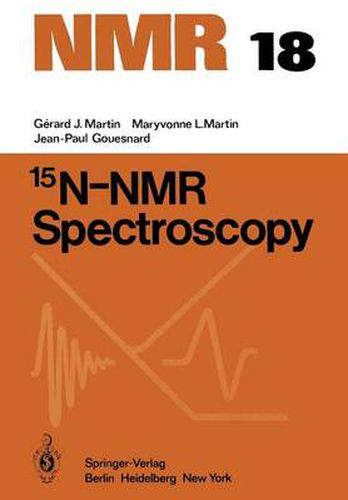Readings Newsletter
Become a Readings Member to make your shopping experience even easier.
Sign in or sign up for free!
You’re not far away from qualifying for FREE standard shipping within Australia
You’ve qualified for FREE standard shipping within Australia
The cart is loading…






This title is printed to order. This book may have been self-published. If so, we cannot guarantee the quality of the content. In the main most books will have gone through the editing process however some may not. We therefore suggest that you be aware of this before ordering this book. If in doubt check either the author or publisher’s details as we are unable to accept any returns unless they are faulty. Please contact us if you have any questions.
After the proton and carbon, nitrogen is, with oxygen, the most impor tant atom in organic and especially bioorganic molecules. However, the development of nitrogen spectroscopy is indeed very recent. This is due to the fact that nitrogen-14, which is the naturally abundant iso tope, suffers, for structural studies, from the disadvantages inherent in nuclei with a quadrupolar moment (Table 1.1). Actually, indirect 15N measurements were reported in the early days of double resonance spectroscopy and the first direct detection of 15N resonance signals at the natural abundance level was realized in 1964 (R 17) at 4.33 MHz 1 (~ 1T) using a 15 mm o.d. cell in the field sweep mode (~ 0.16 min- ). Signal-to-noise ratios only of 3-4 were obtained for neat liquids and this low sensitivity of the 15N resonance still remains the main dis advantage for 15 spectroscopy (Table 1.1). However, nitrogen-15 has, N probably more than any other nucleus, benefited from the advances of NMR technology, i.e. Fourier transformation, multinuclear facilities, wide-bore super conducting solenoids, and, with the new generation of spectrometers, 15N-NMR is entering the field of routine investigation. Nevertheless, in spite of these spectacular improvements, obtaining 15N spectra of diluted species or large biochemical molecules is often not very easy and a good knowledge of the relaxation properties pecu liar to 15N may be necessary in order to adjust the pulse sequences and the decoupler duty cycle correctly (Section 2).
$9.00 standard shipping within Australia
FREE standard shipping within Australia for orders over $100.00
Express & International shipping calculated at checkout
This title is printed to order. This book may have been self-published. If so, we cannot guarantee the quality of the content. In the main most books will have gone through the editing process however some may not. We therefore suggest that you be aware of this before ordering this book. If in doubt check either the author or publisher’s details as we are unable to accept any returns unless they are faulty. Please contact us if you have any questions.
After the proton and carbon, nitrogen is, with oxygen, the most impor tant atom in organic and especially bioorganic molecules. However, the development of nitrogen spectroscopy is indeed very recent. This is due to the fact that nitrogen-14, which is the naturally abundant iso tope, suffers, for structural studies, from the disadvantages inherent in nuclei with a quadrupolar moment (Table 1.1). Actually, indirect 15N measurements were reported in the early days of double resonance spectroscopy and the first direct detection of 15N resonance signals at the natural abundance level was realized in 1964 (R 17) at 4.33 MHz 1 (~ 1T) using a 15 mm o.d. cell in the field sweep mode (~ 0.16 min- ). Signal-to-noise ratios only of 3-4 were obtained for neat liquids and this low sensitivity of the 15N resonance still remains the main dis advantage for 15 spectroscopy (Table 1.1). However, nitrogen-15 has, N probably more than any other nucleus, benefited from the advances of NMR technology, i.e. Fourier transformation, multinuclear facilities, wide-bore super conducting solenoids, and, with the new generation of spectrometers, 15N-NMR is entering the field of routine investigation. Nevertheless, in spite of these spectacular improvements, obtaining 15N spectra of diluted species or large biochemical molecules is often not very easy and a good knowledge of the relaxation properties pecu liar to 15N may be necessary in order to adjust the pulse sequences and the decoupler duty cycle correctly (Section 2).